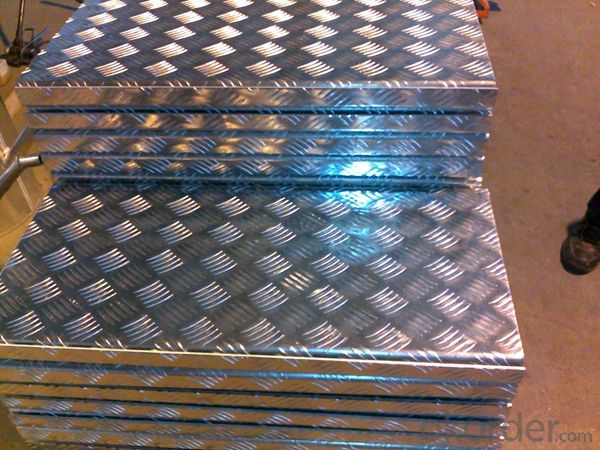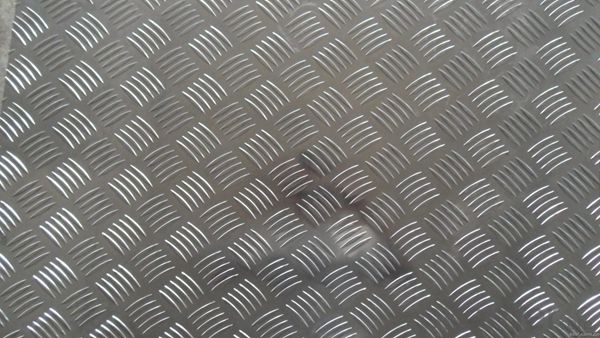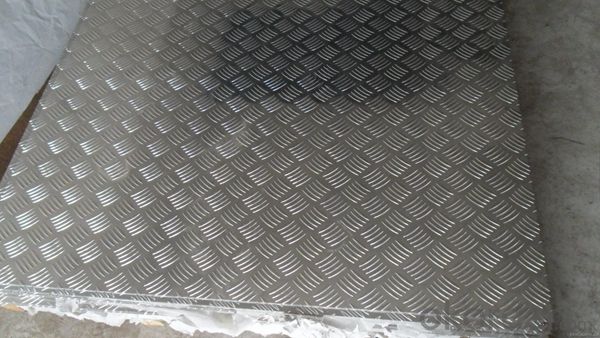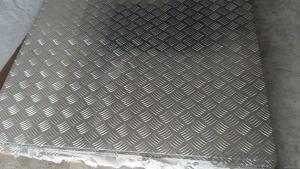Checkered Aluminium Sheet 5005 Alloy for Automotive
- Loading Port:
- Shanghai
- Payment Terms:
- TT OR LC
- Min Order Qty:
- 5 m.t.
- Supply Capability:
- 10000 m.t./month
OKorder Service Pledge
OKorder Financial Service
You Might Also Like
Item specifice
1. Specification of Checkered Aluminium Sheet 5005 Alloy for Automotive
EQUIPMENT | Double coating double baking; |
CAPACITY | 5000Mt/week |
SIZE | Thickness 0.18mm—2mm, width 40mm—1250mm |
PAINT THICKNESS | Top:18--25um, back:5-7um |
COIL WGT | 3Mt - 8Mt |
COIL ID | φ508mm,φ610mm |
SURFACE PAINT | EP, PE, HDP, SMP, PVDF |
COLOR SERIES | RAL color number series |
2. Application of Checkered Aluminium Sheet 5005 Alloy for Automotive
(1).Interior: wall cladding, ceilings, bathrooms, kitchens and balconies, shutters, doors...
(2).Exterior: wall cladding, facades, roofing, canopies, tunnels,column covers , renovations...
(3).Advertisement: display platforms, signboards, fascia, shop fronts...
3. Feature of Checkered Aluminium Sheet 5005 Alloy for Automotive
Surfact Quality :
Be free from Oil Stain, Dent, Inclusion, Scratches, Stain, Oxide Dicoloration, Breaks, Corrosion, Roll Marks, Dirt Streaks and other defect which will interfere with use,
Mechenical Property:
Chemical Composite and Mechanical Property
4. Certificate:
SGS and ROHS(if client request, paid by client), MTC(plant provided), Certificate of Origin(FORM A, FORM E, CO), Bureau Veritas and SGS (if client request, paid by client), CIQS certificate
5. Image of Checkered Aluminium Sheet 5005 Alloy for Automotive



6. Package and shipping of Checkered Aluminium Sheet 5005 Alloy for Automotive
First, plastic cloth with drying agent inside; Second, Pearl Wool ; Third, wooden cases with dry agent , fumigation wooden pallets, aluminum surface could cover blue PVC film
7. FAQ
1) What is the delivery time?
Dpends on actual order, around 20 to 35 days
2)What is the QC system:
We have QC staff of 20 persons and advanced equipment, each production is with MTC traced from Aluminum ingot lot.
3) What market do you mainly sell to?
Australia, America, Asia, Middle East, Western Europe, Africa etc
- Q:What is the typical thermal conductivity of aluminum sheets?
- The typical thermal conductivity of aluminum sheets is approximately 205-230 watts per meter-kelvin (W/mK). This high thermal conductivity makes aluminum an excellent heat conductor, which is why it is commonly used in applications where heat transfer is important, such as in heat sinks, power transmission lines, and cooking utensils.
- Q:Are the aluminum sheets suitable for manufacturing sporting equipment?
- Aluminum sheets prove to be a suitable choice for the production of sporting equipment. This is due to aluminum being a material that is both lightweight and durable, offering various advantages in the manufacturing process. Its exceptional strength-to-weight ratio makes it highly suitable for applications where strength is necessary, while still keeping the overall weight of the equipment low. Moreover, aluminum possesses a high level of resistance to corrosion, a crucial quality for sporting equipment that is frequently exposed to diverse weather conditions. In addition to this, aluminum can be easily molded into different shapes and sizes, granting manufacturers the ability to create personalized equipment for a range of sports. In summary, utilizing aluminum sheets in the manufacturing of sporting equipment guarantees the creation of top-quality, lightweight, and long-lasting products that enhance performance and durability.
- Q:Are aluminum sheets suitable for use in food processing or packaging industries?
- Yes, aluminum sheets are suitable for use in food processing and packaging industries. Aluminum is a versatile and widely used material in the food industry due to its excellent properties and advantages. Firstly, aluminum is a non-toxic material, making it safe for direct contact with food. It does not react with food or alter its taste, ensuring the preservation of the original flavor and quality. This is particularly important in the packaging industry, as it helps to maintain the freshness and integrity of the food product. Secondly, aluminum has excellent thermal conductivity, which allows for efficient and even heat distribution during food processing. This property is beneficial for cooking, baking, and other thermal processes, ensuring that food is cooked or processed evenly. Additionally, aluminum sheets offer excellent barrier properties, such as resistance to moisture, light, and gases. This helps to protect food from external factors that could potentially deteriorate its quality, such as moisture or oxygen. It also helps to prolong the shelf life of packaged food products. Furthermore, aluminum sheets are lightweight, yet strong and durable. This makes them easy to handle and transport in food processing and packaging operations. Their strength and durability ensure that the packaging remains intact and protects the food during transportation and storage. Lastly, aluminum is a sustainable material. It is 100% recyclable, meaning that it can be reused without losing its properties. This helps to reduce the environmental impact and supports the circular economy. In conclusion, aluminum sheets are highly suitable for use in the food processing and packaging industries. Their non-toxic nature, thermal conductivity, barrier properties, lightweight yet strong characteristics, and sustainability make them an ideal choice for ensuring the safety and quality of food products.
- Q:What are the different methods of surface finishing for aluminum sheets?
- There are several methods of surface finishing for aluminum sheets, each with its own advantages and applications. Some of the common methods include: 1. Anodizing: This process involves immersing the aluminum sheet in an electrolytic solution and applying an electric current to create a protective oxide layer on the surface. Anodizing provides excellent corrosion resistance, durability, and can be colored or dyed for aesthetic purposes. 2. Polishing: Polishing is a mechanical process that involves buffing the aluminum sheet to create a smooth and reflective surface. It is commonly used for decorative applications and to enhance the appearance of the metal. 3. Brushing: Brushing involves using abrasive materials or brushes to create a directional grain pattern on the aluminum sheet's surface. This method is often used for architectural applications or to achieve a distinctive textured finish. 4. Powder coating: Powder coating involves applying a dry powder paint to the aluminum sheet's surface and then curing it under heat. This process provides a durable and vibrant finish, offering excellent resistance to weathering, chemicals, and UV rays. 5. Chemical etching: Chemical etching involves using acidic or alkaline solutions to selectively remove the aluminum from the sheet's surface, creating a textured or patterned design. This method is commonly used for decorative purposes or to enhance adhesion for subsequent coatings. 6. Laminating: Laminating involves bonding a protective film or layer onto the aluminum sheet's surface. This method provides added protection against scratches, stains, and other physical damage while also allowing for customization through different film finishes. 7. Sandblasting: Sandblasting uses high-pressure air or water to propel abrasive particles onto the aluminum sheet's surface, creating a textured or matte finish. It is often used to remove impurities, improve paint adhesion, or create a distinctive appearance. These are just a few of the many methods available for surface finishing aluminum sheets. The choice of method depends on the desired appearance, functionality, and specific requirements of the application.
- Q:Its been bugging me for years and i want to know why they say aluminum and not aluminium like it is spelt in the Oxford English dictionary and more importantly the universal periodic table, accepted by all countries, does anyone know why? I would like all opinions on this matter, if possible, thank you
- Aluminum okorder /... It’s clear that the shift in the USA from –ium to –um took place progressively over a period starting in about 1895, when the metal began to be widely available ... The American Chemical Society only adopted it in 1925, though this was clearly in response to the popular shift that had already taken place.
- Q:Can aluminum sheets be used for reflective insulation?
- Yes, aluminum sheets can be used as reflective insulation. Aluminum has excellent reflective properties, allowing it to reflect heat and light effectively. This makes it a suitable material for insulating applications where reflecting radiant heat is desired, such as in roofs, walls, or attics.
- Q:What is the thickness range available for aluminum sheets?
- The thickness range available for aluminum sheets typically varies from 0.006 inches (0.15mm) to 0.25 inches (6.35mm), depending on the specific requirements and application.
- Q:I am doing some exam review and do not know how to do these...Calculate the number of Nitrate ions in 3.99 g or aluminum nitrate.
- ? number of NO3 = 3.99g AlNO3 x(1mol AlNO3/212.996 g AlNO3)x(1mol NO3/1mol AlNO3)x(6.02*10^23 number of NO3/1mol NO3)=11*10^21 number of NO3
- Q:Can aluminum sheet be used for electrical enclosures?
- Yes, aluminum sheet can be used for electrical enclosures. Aluminum is a popular choice for electrical enclosures due to its excellent conductivity, lightweight nature, and corrosion resistance. It provides effective shielding against electromagnetic interference and offers good heat dissipation properties. Additionally, aluminum is easily formable, allowing for the creation of complex shapes and designs. Overall, aluminum sheet is a suitable material for electrical enclosures and is commonly used in various industries including electronics, telecommunications, and power distribution.
- Q:I have to find the type of bond that Aluminum (foil) would have. I know that it has some kind of bond to it because that's the kind of question that I got wrong on my last quiz.
- Yes it will be a covalent bond. The simplest compound will be CH4 where each of the electron from the four H will be shared with one each from C to provide 4 covalent bonds.
1. Manufacturer Overview |
|
|---|---|
| Location | |
| Year Established | |
| Annual Output Value | |
| Main Markets | |
| Company Certifications | |
2. Manufacturer Certificates |
|
|---|---|
| a) Certification Name | |
| Range | |
| Reference | |
| Validity Period | |
3. Manufacturer Capability |
|
|---|---|
| a)Trade Capacity | |
| Nearest Port | |
| Export Percentage | |
| No.of Employees in Trade Department | |
| Language Spoken: | |
| b)Factory Information | |
| Factory Size: | |
| No. of Production Lines | |
| Contract Manufacturing | |
| Product Price Range | |
Send your message to us
Checkered Aluminium Sheet 5005 Alloy for Automotive
- Loading Port:
- Shanghai
- Payment Terms:
- TT OR LC
- Min Order Qty:
- 5 m.t.
- Supply Capability:
- 10000 m.t./month
OKorder Service Pledge
OKorder Financial Service
Similar products
New products
Hot products
Hot Searches
Related keywords


























